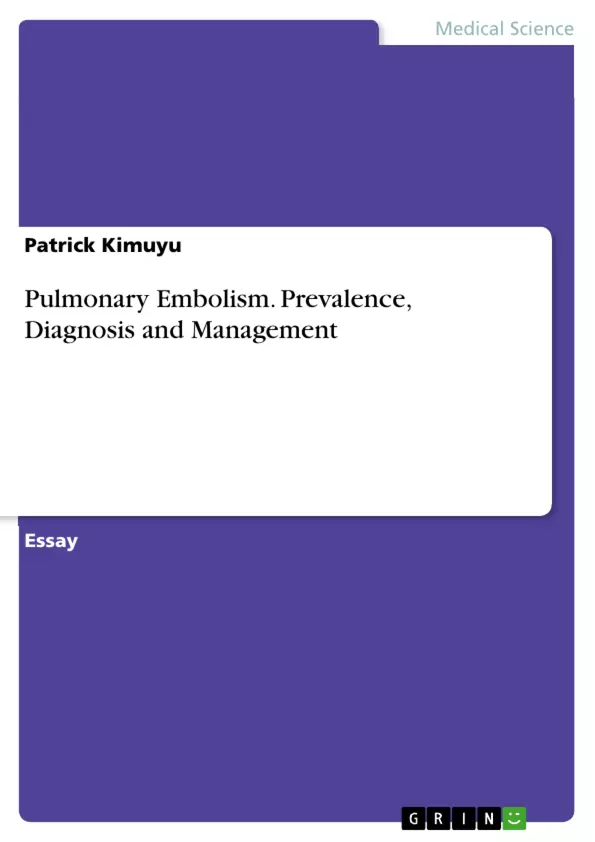Pulmonary embolism is usually a life-threatening condition that occurs due to blockage of the main artery carrying blood to the lungs. This blockage is caused by a blood clot that is carried in the bloodstream to the lung, primarily from the leg following deep vein thrombosis. From a primary care perspective, pulmonary embolism is not considered as a disease with its etiology. Rather, it arises as a complication of a number of conditions that cause venous thrombosis such as deep vein thrombosis, pregnancy and postoperative complications. This literature review focuses on evaluating current evidence based guidelines for diagnosis and management of pulmonary embolism.
Inhaltsverzeichnis (Table of Contents)
- Introduction
- Incidence and Prevalence
- Pathophysiology
- Clinical Implications of Pulmonary Embolism
- Clinical Evidence-based Guidelines
- Wells Score
- PERC (pulmonary embolism rule-out criteria)
- Diagnostic Tests
- Blood Tests
- Imaging
- Electrocardiogram (ECG)
- Echocardiography
- Treatment/management
- Anticoagulant therapy
- Thrombolytic therapy
- Surgery
Zielsetzung und Themenschwerpunkte (Objectives and Key Themes)
This literature review focuses on evaluating current evidence-based guidelines for the diagnosis and management of pulmonary embolism. It aims to provide a comprehensive understanding of the disease from its prevalence and incidence to its pathophysiology, clinical implications, and available diagnostic and treatment options.
- Prevalence and incidence of pulmonary embolism
- Pathophysiology and clinical implications of pulmonary embolism
- Diagnostic tests and criteria for identifying pulmonary embolism
- Evidence-based guidelines for the management of pulmonary embolism
- Treatment options for pulmonary embolism, including anticoagulant, thrombolytic, and surgical interventions
Zusammenfassung der Kapitel (Chapter Summaries)
- Introduction: This chapter introduces the concept of pulmonary embolism, defining it as a potentially life-threatening condition caused by a blood clot obstructing the pulmonary artery. It emphasizes that pulmonary embolism is often a complication of other conditions, such as deep vein thrombosis. The review focuses on evaluating current evidence-based guidelines for its diagnosis and management.
- Incidence and Prevalence: This chapter discusses the prevalence and incidence of pulmonary embolism, highlighting its significant public health burden in the United States. It presents data on the number of new cases and deaths attributed to pulmonary embolism annually, emphasizing the importance of timely diagnosis and intervention.
- Pathophysiology: This chapter delves into the physiological consequences of pulmonary embolism, focusing on its respiratory and hemodynamic effects. It explains how the blockage of the pulmonary artery leads to reduced oxygen supply and increased strain on the heart.
- Clinical Implications of Pulmonary Embolism: This chapter explores the clinical implications of pulmonary embolism, emphasizing the challenges associated with its diagnosis due to its similar signs and symptoms to other conditions. It highlights the potential for severe lung damage and failure of vital organs if timely intervention is delayed.
- Clinical Evidence-based Guidelines: This chapter discusses the development of evidence-based guidelines to improve the diagnosis of pulmonary embolism. It focuses on the use of probability testing tools like the Wells Score and the Geneva Score, as well as the PERC (pulmonary embolism rule-out criteria), which helps rule out the risk of pulmonary embolism.
- Diagnostic Tests: This chapter reviews various diagnostic tests used for pulmonary embolism, including blood tests, imaging, electrocardiogram (ECG), and echocardiography. It emphasizes the role of D-dimer as a primary test for patients with low to moderate probability of pulmonary embolism.
- Treatment/management: This chapter outlines key management approaches for pulmonary embolism, emphasizing the importance of immediate anticoagulant therapy for all suspected cases. It also discusses the use of thrombolytic therapy for acute cases and surgical interventions when necessary.
Schlüsselwörter (Keywords)
Pulmonary embolism, deep vein thrombosis, evidence-based guidelines, diagnosis, management, anticoagulation, thrombolytic therapy, Wells Score, PERC, D-dimer, imaging, echocardiography, clinical implications.
- Arbeit zitieren
- Patrick Kimuyu (Autor:in), 2017, Pulmonary Embolism. Prevalence, Diagnosis and Management, München, GRIN Verlag, https://www.grin.com/document/384976



